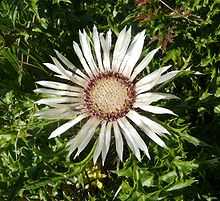Carlina acaulis
| Carlina acaulis | |
|---|---|
 | |
| Scientific classification | |
| Kingdom: | Plantae |
| (unranked): | Angiosperms |
| (unranked): | Eudicots |
| (unranked): | Asterids |
| Order: | Asterales |
| Family: | Asteraceae |
| Tribe: | Cynareae |
| Genus: | Carlina |
| Species: | C. acaulis |
| Binomial name | |
| Carlina acaulis L. | |
Carlina acaulis (stemless carline thistle, dwarf carline thistle, silver thistle) is a perennial dicotyledonous flowering plant in the family Asteraceae, native to alpine regions of central and southern Europe.[1] The specific name acaulis (New Latin for "without a stem," from Latin caulis "stem" or "stalk") and common names are descriptive of the manner in which its flower head rests directly upon a basal leaf rosette.
The spiny, pinnatilobate leaves grow in a basal rosette approximately 20 cm in diameter. The flowers are produced in a large (up to 10 cm) flowerhead of silvery-white ray florets around a central disc. The disc florets are tubular and yellow-brown in colour. To protect the pollen, the head closes in wet weather, a phenomenon folklore holds to presage forthcoming rain.[2] The flowering time is between August and September.
It prefers chalky soils and dry pastures in environments from valleys up to an altitude of 2,800 m.
- Subspecies
There are two subspecies:[1]
- Carlina acaulis subsp. acaulis – inflorescences sessile
- Carlina acaulis subsp. simplex – inflorescences with a short stem
Uses
The rhizome contains a number of essential oils, in particular the antibacterial carlina oxide.[3] The root was formerly employed in herbal medicine as a diuretic and cold remedy.[4]
While young, the flowerhead bud can be cooked and eaten in a similar manner to the Globe artichoke, which earned it the nickname of hunter's bread.
It is sometimes cultivated as a rockery plant, or dried and hung as a house decoration.
In Basque culture it was traditionally used as symbol of good fortune, fixed into the frontal door of the house.
References
- ↑ 1.0 1.1 Flora Europaea: Carlina acaulis, retrieved 2008-01-21
- ↑ Botany Online, Carlina acaulis, weather clock, retrieved 2008-01-21
- ↑ Florkin, Marcel, Comprehensive Biochemistry, Elsevier, p. 216
- ↑ Harborne, Jeffrey B., Chemical Dictionary of Economic Plants, Wiley, p. 12, ISBN 0-471-49226-4